Barber J.R. Intermediate Mechanics of Materials
Подождите немного. Документ загружается.

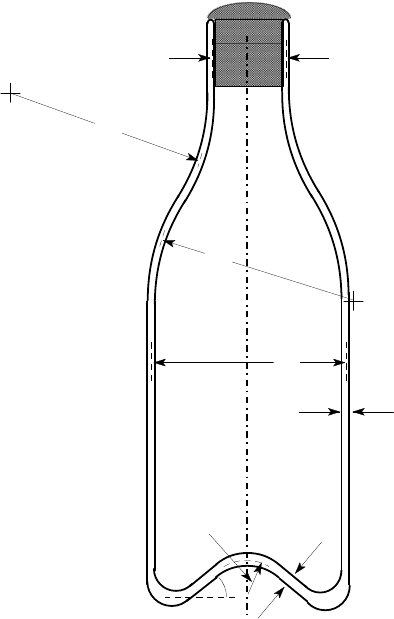
Problems 415
8.16. Figure P8.16 shows the approximate dimensions of a champagne bottle, man-
ufactured from glass of density
ρ
g
= 2400 kg/m
3
. The bottle is to contain liquid of
density 1050 kg/m
3
at a pressure of 30 kPa above atmospheric.
Which of the following quantities are significant enough to require inclusion in a
membrane stress calculation:-
(i) internal pressure,
(ii) weight of contents,
(iii) weight of the glass.
Estimate the maximum membrane stress in the bottle. Why is it necessary to use
an increased wall thickness at the points A−A?
all dimensions in mm
Figure P8.16
o
40
4
85
15 radius
35
90
90
A
A
3
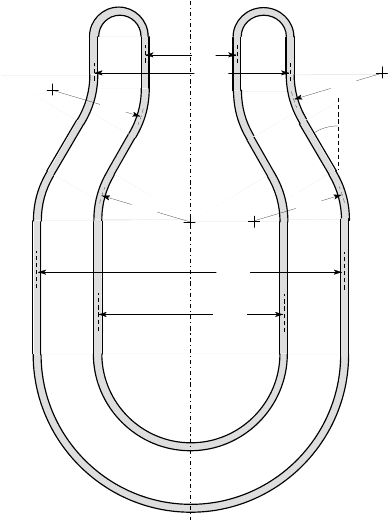
416 8 Membrane Stresses in Axisymmetric Shells
8.17. Figure P8.17 shows the cross section of a vacuum flask for the temporary stor-
age of liquified gasses. The space A between the inner and outer walls is evacuated
and the exposed surfaces are subject to atmospheric pressure of 100 kPa. The vessel
is made of glass of density 2300 kg/m
3
and the wall thickness is everywhere 3 mm,
except at B where the vessel must be stiffened against bending.
Find the maximum tensile membrane stress in the wall, excluding the region B.
A
80
80
80
80
75
170
260
160
B
30
o
all dimensions in mm
Figure P8.17
Section 8.5
8.18. Figure P8.18 shows a thin-walled conical shell of thickness t, semi-angle
α
and
height h. It is loaded by self-weight only, the material of the shell having density
ρ
s
,
Young’s modulus E and Poisson’s ratio
ν
.
Determine the membrane stresses
σ
1
,
σ
2
at the base of the shell and hence find
the radial displacement u
r
at the base of the shell.
Note: The surface area of a cone of semi-angle
α
and height h is
π
h
2
tan
α
/cos
α
.
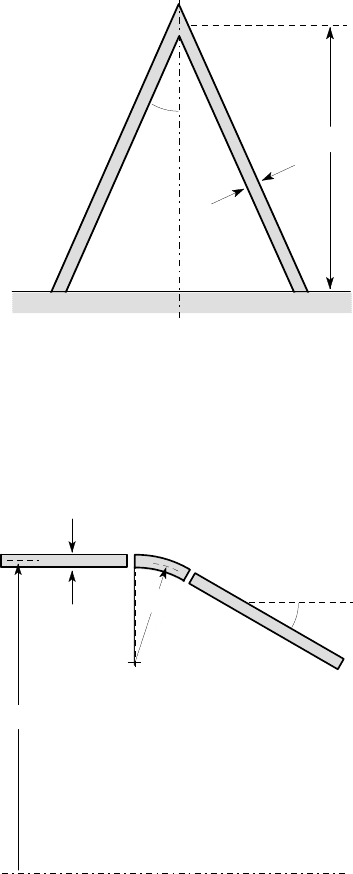
Problems 417
t
h
α
Figure P8.18
8.19. For the toroidal transition between the cylinder and the cone shown in Fig-
ure P8.19, find the membrane stresses
σ
1
,
σ
2
at the points A
1
,A
2
,B
1
,B
2
, due to an
internal pressure of 1 MPa, if the wall thickness is 10 mm.
30
o
10
1
A
2
A
1
B
2
B
1
O
300
1000
c
L
all dimensions in mm
Figure P8.19
Hence find the circumferential strain and the radial displacement at these points,
if the material is steel (E =210 GPa,
ν
=0.3).
Sketch the distorted shapes of the shell sections at the transition and show how
local bending will re-establish continuity of displacement.
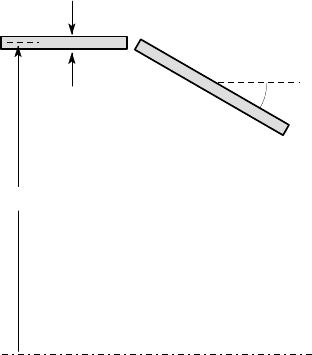
418 8 Membrane Stresses in Axisymmetric Shells
8.20. Repeat the calculation of Problem 8.19 for the points A
1
,A
2
, assuming there is
no toroidal transition — i.e. the cone is directly joined to the cylinder as shown in
Figure P8.20.
30
o
10
1
A
2
A
1000
c
L
all dimensions in mm
Figure P8.20
Comment on the relation between the answers to Problems 8.19, 8.20. Will the tran-
sition reduce the local bending stresses, as we would intuitively expect, or not? If so,
explain what is missing in the argument of Problem 8.20.
8.21. A cylindrical shell of radius a, thickness t is to be capped by a hemispherical
shell of radius a and thickness t
1
. It is proposed to eliminate the bending effects at
the discontinuity, discussed in §8.5.1, by choosing t
1
so as to cause the membrane
radial displacements u
r
in the cylinder and the hemisphere to be equal. What is the
required ratio t
1
/t, if the material has Young’s modulus E and Poisson’s ratio
ν
?
8.22. A spherical shell of mean radius a and thickness t rotates at angular velocity
Ω
about a diameter. There is no internal pressure.
Find the membrane stresses as functions of polar angle and hence find the radial
displacement at the equator. The material has density
ρ
, Young’s modulus E and
Poisson’s ratio
ν
.
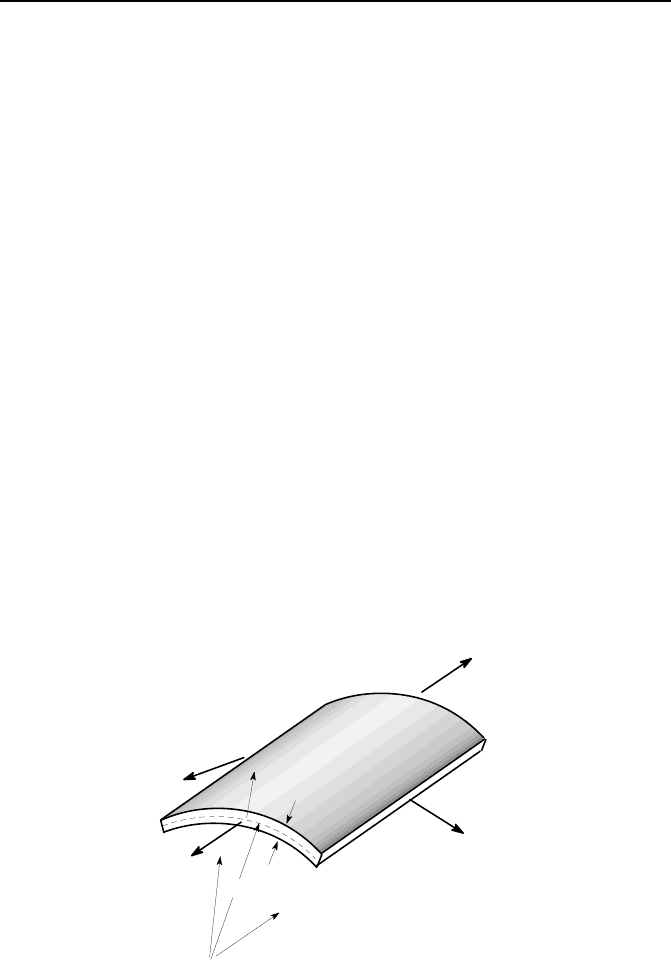
9
Axisymmetric Bending of Cylindrical Shells
We saw in the last chapter that the equilibrium equations for an axisymmetric shell
can be satisfied by membrane stresses
σ
1
,
σ
2
, which are uniform through the thick-
ness of the shell. However, the radial displacements predicted by the membrane
theory generally involve discontinuities at the supports or wherever there is a dis-
continuity in radius or thickness. In such cases, continuity is restored by localized
bending of the shell. In the present chapter, we shall investigate the axisymmetric
bending of cylindrical shells, but important features of the results carry over to other
axisymmetric shell bending problems.
9.1 Bending stresses and moments
As in the bending of beams, shell bending involves stresses that vary linearly through
the shell thickness. In combination with the membrane stresses, they constitute the
first two terms in a Taylor series expansion of the variation of normal stress through
the thickness.
η
r
z
O
t
σ
θθ
σ
θθ
σ
zz
σ
zz
a
Figure 9.1: Coordinate system and stresses for a shell element
J.R. Barber, Intermediate Mechanics of Materials, Solid Mechanics and Its Applications 175,
2nd ed., DOI 10.1007/978-94-007-0295-0_9, © Springer Science+Business Media B.V. 2011
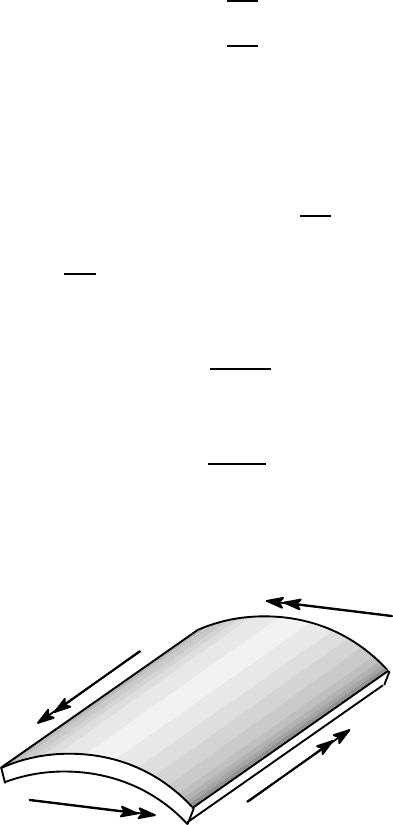
420 9 Axisymmetric Bending of Cylindrical Shells
Figure 9.1 shows the longitudinal stress
σ
zz
and the circumferential stress
σ
θθ
acting on an element of cylindrical shell of mean radius a. To decouple membrane
and bending stresses, it is convenient to define a coordinate
η
in the direction of the
outward normal and measured from the mid-plane of the shell. In other words, the
distance from the cylinder axis is r = a+
η
. This is equivalent to the location of the
origin at the centroid in beam bending problems. The bending theory is then based
on the assumption that the local stress field can be written in the form
σ
zz
=
σ
1
+
s
1
η
t
(9.1)
σ
θθ
=
σ
2
+
s
2
η
t
, (9.2)
where the constant terms
σ
1
,
σ
2
are the membrane stresses already defined in Chapter
8, and the linearly varying terms represent the bending stresses.
The stress
σ
θθ
in equation (9.2) has a resultant bending moment M
θ
per unit
length of shell, given by
M
θ
=
Z
t/2
−t/2
σ
θθ
η
d
η
=
Z
t/2
−t/2
σ
2
+
s
2
η
t
η
d
η
=
s
2
t
2
12
. (9.3)
We can use this result to eliminate s
2
in equation (9.2), obtaining
σ
θθ
=
σ
2
+
12M
θ
η
t
3
. (9.4)
A similar procedure with
σ
zz
gives
σ
zz
=
σ
1
+
12M
z
η
t
3
, (9.5)
where M
z
is the bending moment per unit circumference. Notice that M
θ
,M
z
are
bending moments per unit length and hence they have units of force (e.g. Nm per m
≡ N). They act on the edges of the shell element in the sense defined in Figure 9.2.
M
z
M
z
M
θ
M
θ
Figure 9.2: Bending moments acting on the shell element
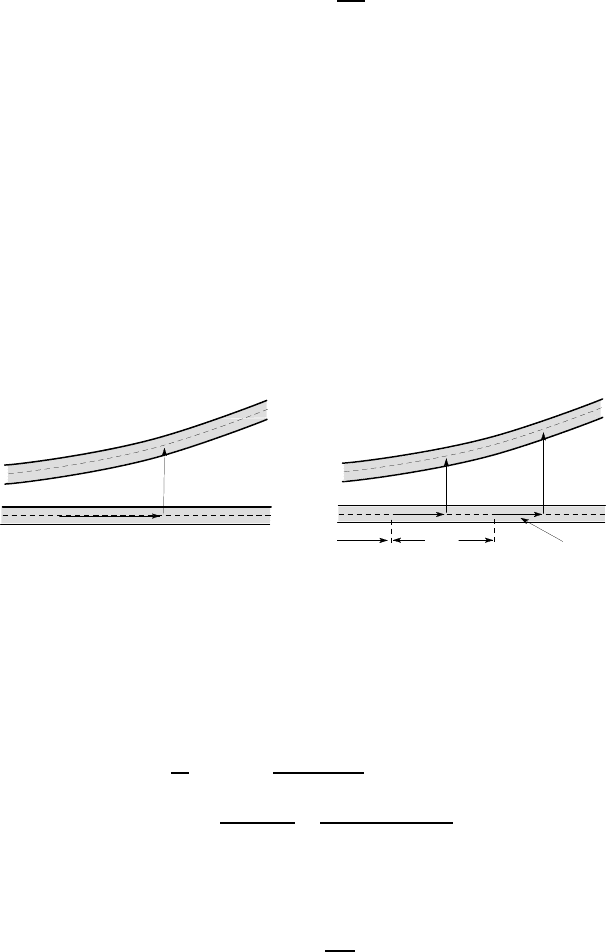
9.2 Deformation of the shell 421
The sign convention is chosen such that positive moments generate tensile
stresses at the outside of the shell, where
η
> 0. The maximum bending stresses
occur at
η
=±t/2 and are
σ
max
= ±
6M
t
2
. (9.6)
The bending stresses are additive to the membrane stresses [see equations (9.1, 9.2)],
so generally we shall find that the maximum total stress in a shell will occur in a
region of localized bending.
9.2 Deformation of the shell
A general axisymmetric deformation of a cylindrical shell can be characterized by
the radial and axial displacements, u
r
and u
z
respectively, of the shell mean surface
as functions of the axial co-ordinate z. These displacements are illustrated in Figure
9.3 (a), where the horizontal straight line represents the position of the shell mean
surface before deformation. The point A on this line moves to A
′
as a result of com-
bined membrane and bending deformations.
.
A
.
A
-
u
z
u
r
.
A
.
A
-
.
B
.
-
B
z
δz
u
z
(z)
(z+δz)
u
z
(z)
u
r
u
r
(z+δz)
(a) (b)
Figure 9.3: (a) Definition of displacement components, (b) deformation of the shell
element AB
The cross section of the cylinder remains circular and, as in §8.5, we conclude
that the circumferential strain e
θθ
=u
r
/a. Hooke’s law then gives
u
r
a
= e
θθ
=
σ
θθ
−
νσ
zz
E
=
σ
2
−
νσ
1
E
+
12(M
θ
−
ν
M
z
)
η
Et
3
. (9.7)
We argued in Example 8.2 that the radial stress
σ
rr
is negligible compared with
σ
θθ
,
σ
zz
and hence the corresponding radial strain,
e
rr
=
∂
u
r
∂
r
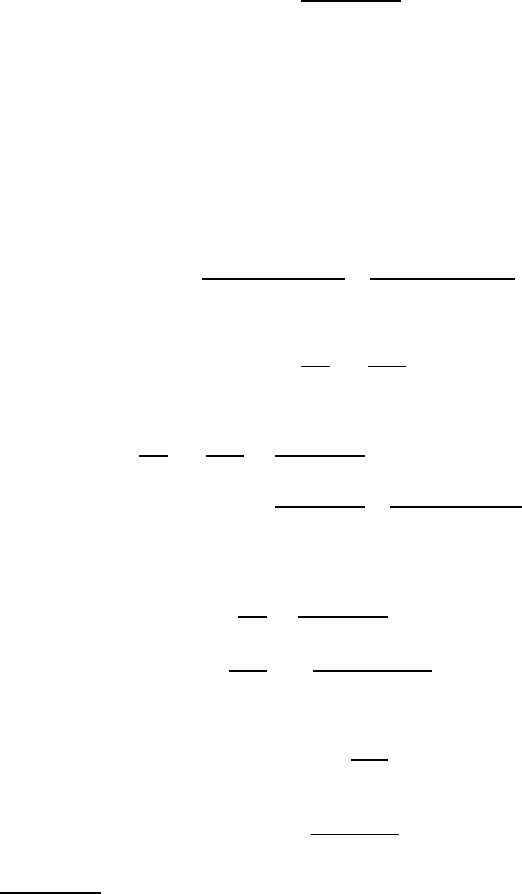
422 9 Axisymmetric Bending of Cylindrical Shells
is also negligible.
1
It follows that u
r
cannot be a function of
η
, so the term varying
with
η
in equation (9.7) must be zero, leading to the results
M
θ
=
ν
M
z
(9.8)
u
r
=
(
σ
2
−
νσ
1
)a
E
. (9.9)
As in the elementary bending theory, we assume that plane transverse sections
remain plane and perpendicular to the local shell wall. The deformation of a typical
element AB of length
δ
z is shown in Figure 9.3 (b). The mean line increases in length
by the amount
u
z
(z +
δ
z) −u
z
(z)
and the section at B rotates anticlockwise relative to that at A through the angle
u
′
r
(z +
δ
z) −u
′
r
,
where u
′
r
≡du
r
/dz. The longitudinal strain is therefore
e
zz
=
u
z
(z +
δ
z) −u
z
(z)
δ
z
−
[u
′
r
(z +
δ
z) −u
′
r
]
η
δ
z
and in the limit
δ
z →0 we have
e
zz
=
du
z
dz
−
η
d
2
u
r
dz
2
.
Using this result and Hooke’s law, we obtain
du
z
dz
−
η
d
2
u
r
dz
2
=
σ
zz
−
νσ
θθ
E
=
(
σ
1
−
νσ
2
)
E
+
12(M
z
−
ν
M
θ
)
η
Et
3
, (9.10)
from equations (9.4, 9.5). This equation must be satisfied for all z,
η
, so we can
equate coefficients of
η
, obtaining
du
z
dz
=
(
σ
1
−
νσ
2
)
E
(9.11)
d
2
u
r
dz
2
= −
12(M
z
−
ν
M
θ
)
Et
3
. (9.12)
Furthermore, we can eliminate M
θ
from (9.12) using (9.8), with the result
M
z
= −D
d
2
u
r
dz
2
, (9.13)
where
D =
Et
3
12(1 −
ν
2
)
(9.14)
is known as the stiffness of the shell.
1
It might be argued that the membrane stresses
σ
1
,
σ
2
will generate a non-negligible Pois-
son’s ratio strain e
rr
. However, a more rigorous treatment including this effect shows that
the resulting modification of equation (9.8) is still small of order t/a (see Problem 9.1).
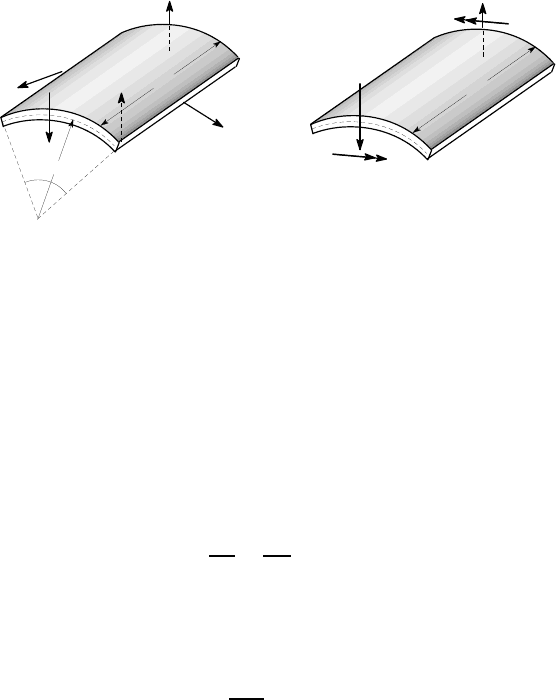
9.3 Equilibrium of the shell element 423
9.3 Equilibrium of the shell element
As in §8.2, we can write an equilibrium equation for the forces acting on the shell
element in the normal direction, but when bending is included this equation will also
include transverse shear forces. Figure 9.4 (a) shows the appropriate forces acting on
the element a
δθδ
z. Notice that the lengths
δ
x,
δ
y in Figure 8.8 are here replaced by
δ
z,a
δθ
respectively. We also include transverse shear forces V (z) per unit length on
the curved edges of the element. There can be no shear forces on the straight edges
because the deformation is axisymmetric.
O
a
δθ
V(z)aδθ
V(z+δz)aδθ
paδθδz
δz
2
σ tδz
2
σ tδz
δz
Vaδθ
Vaδθ
M(z)aδθ
M(z+δz)aδθ
(a) (b)
Figure 9.4: Equilibrium of (a) forces and (b) moments on the shell element
Summing the forces in the direction of the outward normal, we obtain
[V (z +
δ
z) −V(z)]a
δθ
+ pa
δθδ
z −
σ
2
t
δ
z
δθ
= 0 .
Here, the second term arises from the internal pressure p acting on the area a
δθδ
z
and the last term is the resultant of the two forces
σ
2
t
δ
z and is obtained exactly as in
the derivation of equation (8.2).
Dividing through by a
δθδ
z and taking the limit as
δ
z→0, we obtain
dV
dz
=
σ
2
t
a
− p . (9.15)
A second equation is obtained by considering the moment equilibrium of the
element under the action of the bending moments and shear forces shown in Figure
9.4 (b). We obtain
dM
z
dz
= V . (9.16)
Alternatively, this result can be considered as another case of equation (6.1), regard-
ing the shell element as a beam of unit width.
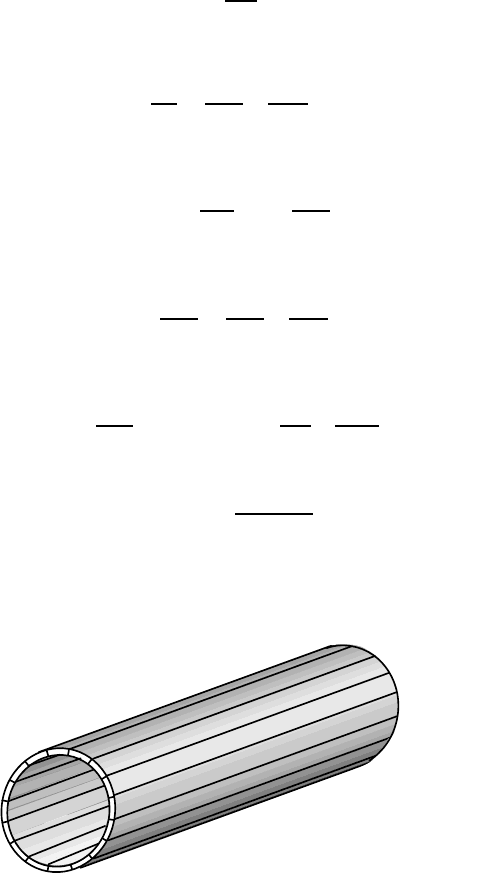
424 9 Axisymmetric Bending of Cylindrical Shells
9.4 The governing equation
These equations can be expressed in terms of the radial displacement u
r
, to obtain
the governing equation for shell deformation. We first note that
σ
2
=
Eu
r
a
+
νσ
1
, (9.17)
from equation (9.9) and hence
dV
dz
=
Eu
r
t
a
2
+
νσ
1
t
a
− p , (9.18)
from (9.15). We can also use equation (9.13) to write (9.16) in terms of u
r
, obtaining
V =
dM
z
dz
= −D
d
3
u
r
dz
3
. (9.19)
Eliminating V between (9.18, 9.19), we then obtain
−D
d
4
u
r
dz
4
=
Eu
r
t
a
2
+
νσ
1
t
a
− p .
This is conveniently rearranged in the form
d
4
u
r
dz
4
+ 4
β
4
u
r
= 4
β
4
pa
2
Et
−
νσ
1
a
E
, (9.20)
where we define
β
4
=
3(1 −
ν
2
)
a
2
t
2
(9.21)
and we have used (9.14) to simplify the multiplying constants. Equation (9.20) is the
governing equation for axisymmetric bending of a circular cylindrical shell of radius
a and thickness t.
Figure 9.5: The shell considered as a set of connected beams
